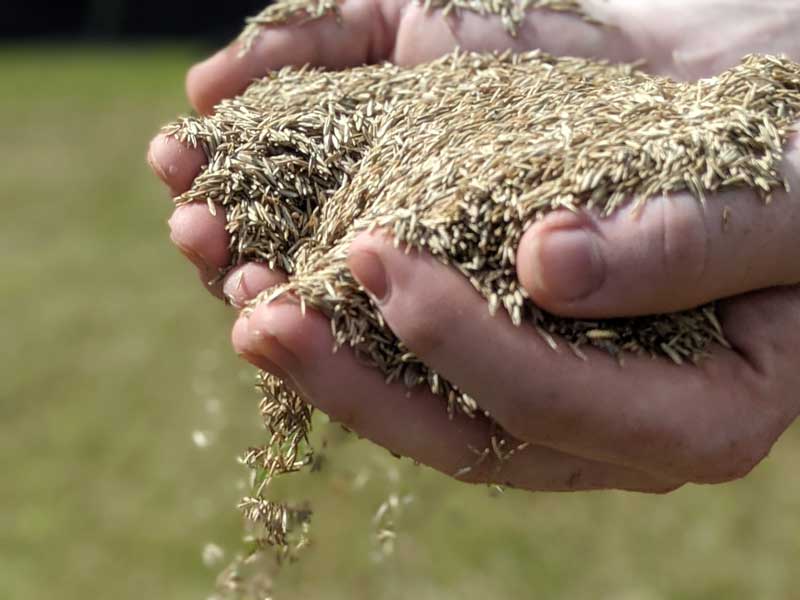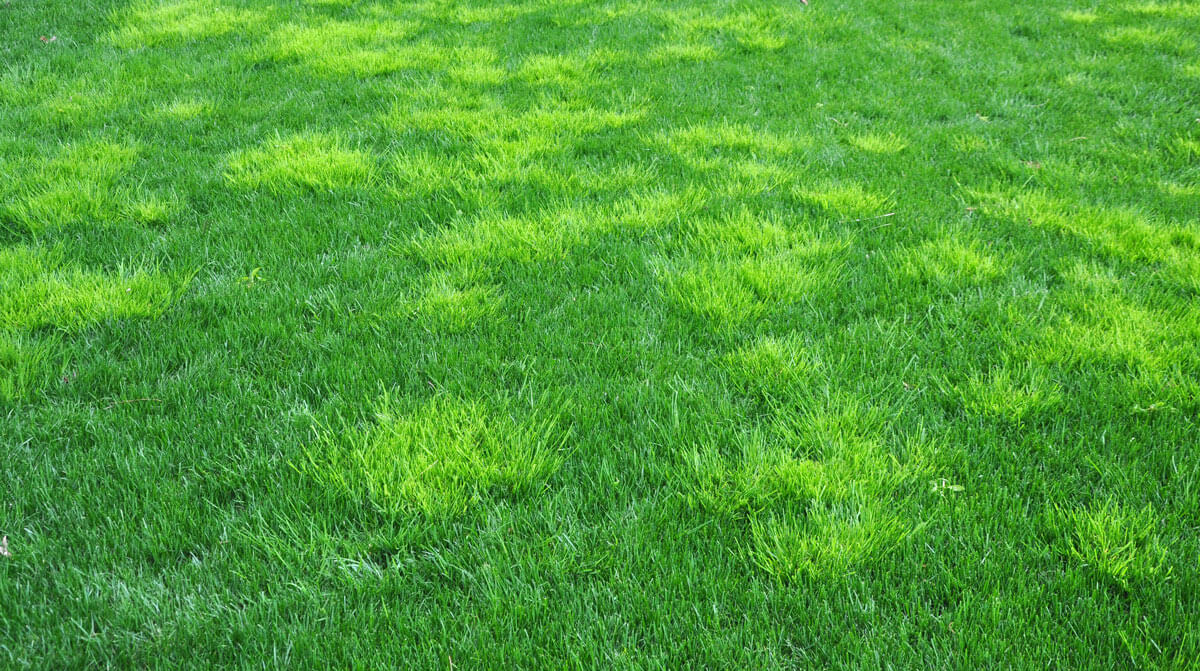Whether you are repairing or replacing a lawn, choosing the right seedmix is imperative. So what IS the best grass seed for your lawn?

I always think that choosing lawn seed is an awful lot like choosing a life partner. There might be some compromises along the way but you need a mix that will like your garden and your lawn care regime. In return, you have like what you see and be able to help the grass to thrive. So what do you need to consider.
As a rule of thumb, choose your grass species for their functionality rather than their looks. A healthy lawn is almost always a good looking one. Go for grass species that thrive in your soil type and cope well with the way you want to use and care for your lawn.
Know your lawn grass species
There are literally more species of grass than I care to shake a stick at. But not all of them will make a great lawn. Some make great hay, some are used for silage and grazing livestock. Then there are grasses that are used to stablilise river banks and sand dunes. Don’t forget too that much of our food comes from the edible seeds of (wheat, barley and maize)
Let’s take a look at the most commonly used lawn grass species. Most of the seed available in garden centres will be a mix of two or more of these.

Perennial ryegrass
Fast to germinate, this is a robust type of grass. Agricultural ryegrasses can be quite coarse but the ones bred especially for lawns are fine leaved and very easy to grow.
Great for a family lawn, but perennial ryegrass isn’t keen on being mown really short. It’s generally really good for colour though. Ryegrass tends to have deep green lustrous leaves with a bit of a shine to them. In fact one way to identify ryegrass is to examine a blade of grass. If it’s glossy on one side, it’s probably a ryegrass.
The fescue family
Fescues tend to be fine leaved grasses that recover well from cutting. These have a high shoot density and give a lawn a lovely velvety texture. They’re also nicely shade tolerant but some cultivars are susceptible to redthread disease. These are also the first grasses to lose their colour during a hot dry summer. A fescue lawn does need regular scarifying because these grasses are very good at producing thatch.
Strong creeping red fescue
As the name suggests, this type of fescue is rather good at spreading itself. It forms rhizomes – underground stems which can propagate new plants if they encounter a bare patch in the lawn.
This is a good seed to mix with perennial ryegrass because it germinates quickly and won’t be overwhelmed by the other species.
Very good at tolerating salt – so if you’re near the seaside, strong creeping red fescue will be a good choice for you. Strong creeping red is less tolerant of really close mowing. Choose your cultivars with care.
Chewings Fescue
Slender leaves and a slightly tuft forming growth habit. Chewings fescue doesn’t spread as enthusiastically as strong creeping red fescue but it tolerates close mowing really well. Some cultivars can be maintained as short as 4mm.
Hard Fescue
Superior tolerance to drought, quick recovery from stress and barely fazed by salt laden winds, hard fescue is a good all-rounder for fine lawns. Most cultivars can be mown as short as 5mm
Really good winter colour too.
Browntop Bent

Commonly found in golf greens and bowling greens. Bowntop bent is wonderfully fine-leaved and very low growing. However, it can be prone to lawn diseases. If you have the time to look after it, you will be rewarded by a beautifully textured lawn with a nice dense sward, but be prepared for plenty of feeding, frequent mowing and regular scarifying.
RTF – Rhizomatous Tall Fescue
A relative newcomer to the turfgrass market, rhizomatous tall fescue has been bred from woodland grasses. It’s incredibly resilient to shade and drought. As the name suggests, it has strong rhizomes that really help it to populate an area.
Great for a shaded lawn but does not tolerate close mowing and it can be quite coarse leaved. I’d happily use it for an informal lawn in an orchard.
Smooth Stalked Meadow Grass
Quite slow to germinate but worth waiting for. Smooth stalked meadow grass is a good companion for perennial ryegrass and is often used by turf growers. I wouldn’t call it fine-leaved but the grass blades are not so wide as to be ugly.
What I do like about this grass is that it will spread via rhizomes to repair small bare areas in a lawn. If your lawn is regularly played on by children or pets, this is a good grass seed to add to the mix.
Supranova poa supine
Another shade tolerant grass seed, Supranova poa supine has been bred from alpine meadow grasses that spend a good part of the year beneath deep snow. It’s just as happy in sunshine as it is in the shade so it’s a great grass for lawns beneath deciduous trees.
It does have quite a chunky leaf blade and isn’t too keen on close mowing, but it is slow growing. So if your perfect lawn is one that doesn’t need too much attention, this grass seed is worth investigating.
Choosing grass seed cultivars
I’ve talked a little bit about the grass seed families, but within each family there are many different cultivars. This is something that happens a lot in the plant world. Take roses for example. There’s the main plant group, or genus. That then gets divided up into families such as bush roses, climbing roses, hybrid tea roses etc. Then within each family there are dozens of named cultivars, things like “iceberg” or “wedding day”.
Grass seed is just the same. We have the overall family with the latin name Graminae. That covers all grasses including wheat, barley, ornamental grasses and lawn grasses.
Within the genus are different species – perennial ryegrass, poa annua (a weed!), smooth stalked meadow grass etc
Then within each species are cultivars.
When I’m repairing utility or family lawns I’ll use a Premium Grass Seed mix from Boston Seeds that contains a mix of varieties of Perennial Ryegrass and Slender Creeping Red Fescue independently recommended by the Sports Turf Research Institute.
The mix of cultivars is important. Each one will have all of the family traits, but they are also have their own character. Some are better at resisting disease, others hold their colour well in winter.
Understanding grass seed cultivars
When you are looking for grass seed for your own lawn, it’s well worth getting your hands on a copy of the STRI Turfgrass Booklet.
The STRI (Sports Turf Research Institute) is based in Bingley in Yorkshire and every year it grows test areas of hundreds of different cultivars. The grasses are monitored carefully throughout the year and scored on lots of different criteria. The tests are run for grasses that are maintained at specific lengths so that you can see how well a cultivar adapts to close mowing.
- Live ground cover (how well does it cover the soil)
- Visual merit (how good does it look)
- Recovery (how well it copes with wear and tear)
- Shoot density (how velvety is the sward)
- Fineness of leaf (a measure of the width of each grass blade)
- Resistance to red thread disease
- Winter greenness
- Summer greenness
Studying the booklet will help you to come up with a seed mixture that will suit your lawn and your lifestyle. Or it might blow your mind!

Why mix different types of grass seed?
It’s very rare to create a lawn from just one grass cultivar. Why? Because there’s no one grass that will look and perform perfectly all year every year. Conditions in your lawn are forever changing, it might be dry one week, sodden the next. Wear and tear differs across the lawn, as do light, shade, drainage, exposure to wind and rain…..you get my drift.
By carefully selecting your cultivars you can create a mix that suits all of your lawn all year round. When one species is loving the weather, another might be doing less well, but a month later, they’ll swap roles. Whereas if you only had one cultivar in there, you’d really notice if it the grass was looking a bit under par.
Which mix will suit my lawn the best?
Every lawn is different. Think about the conditions in your garden, how you want to use your lawn, what you want it to look like and how much time you want to spend on lawn care.
The way you maintain your lawn is just as important as the initial seedmix. As a rule of thumb, hardwearing lawns (and sportsfields) will benefit from being maintained at around 5cm long.

For a family lawn that’s easy to care for
Choose a seed mix that contains around 50% perennial ryegrass with some fescues and perhaps a little highland bent, such as Boston Seeds Childsplay Grass Seed.
For a family lawn in a shaded garden
Fescues are great for shade tolerance but you’ll also need a more hard-wearing species alongside them. Take a look at Boston Seeds Shady Place Grass Seed.
For lawns on dry soils
Fescues are a must but try to incorporate. Try a mix of tall fescue and perennial ryegrass for drought tolerance and good colour. Maintain at around 5cm long
For close mown lawns
Go for a classic fescue-bent mix – but only if you are prepared for regular lawn treatments, scarification and aeration to keep it in rude health. Try Boston Seeds Quality Fine Lawn Seed or Bowling and Putting Green Grass Seed
For front gardens and ornamental lawns
Honestly, you can’t go wrong a nice mix of dwarf perennial ryegrass and fescues. Pick disease resistant cultivars and aim for a good balance between summer greenness and winter greenness so that it will look good all year round. My go-to mixture is Boston Seeds Premier Lawn Seed
More advice
Still scratching your head? Follow my YouTube Channel for lots of information and updates on growing a lawn from seed. And remember, the ongoing lawn care is just as important as the seed mix you choose. As I said in the introduction, choosing grass seed is like marriage – not only do you have to find a suitable partner, you have to work to bring out the best in them. Good luck – and if you have any questions, please don’t hesitate to get in touch
Follow Premier Lawns on YouTube for information-packed lawn themed videos
Thinking about an alternative lawn? Here’s how they compare to the real thing

